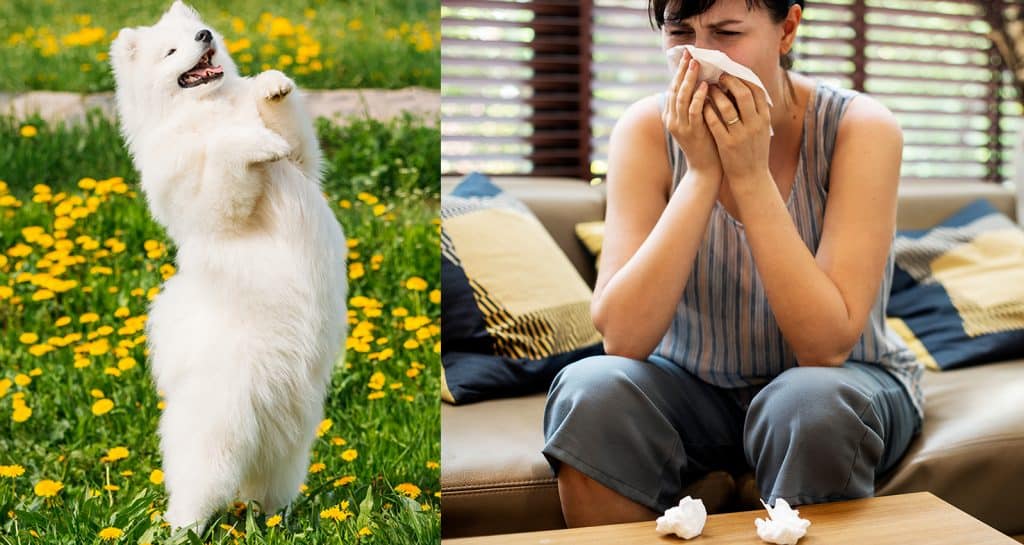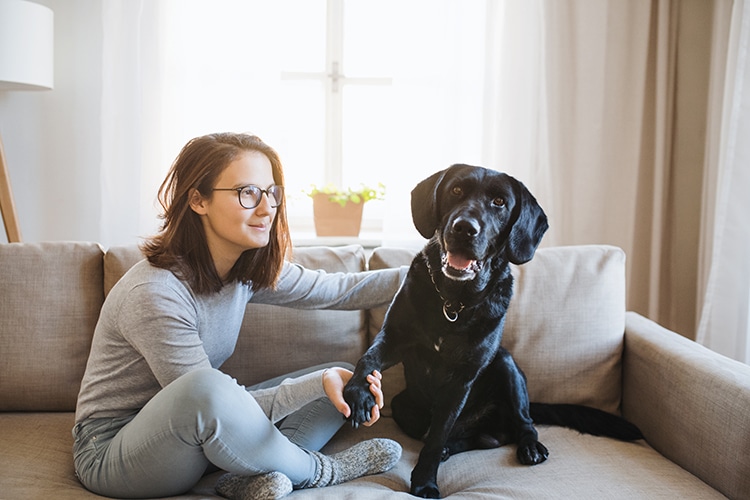There’s no doubt that we love our furry friends. According to the American Pet Products Association, about 67% of American homes have a pet.
But what happens when someone is allergic to dogs? The American College of Allergy, Asthma, and Immunology estimates that up to 10% of Americans have a dog allergy. Just what causes the allergic reaction, and is there anything we can do to manage the allergy?
In this article, we’ll examine:
Let’s start at the beginning, with dog dander and its role in dog allergies.
Most people think that a dog’s hair or fur causes allergies, but that’s not the case. The allergic response is a reaction to minute protein particles left on the skin from sweat, urine, or saliva. Each day, your pooch sheds flakes of old skin, and this sloughed skin is known as dander.
Because it comes from skin flakes, dander looks like tiny flecks of dandruff or household dust. The problem is these particles can be microscopic in size and hard to see.
How does it Spread?
The short answer is that it flies. Dog dander is all over the place; it can even be in homes that don’t have pets. That’s because the tiny particles take to the air before they settle on furniture, floors, and other surfaces. According to WebMD, 90% of US households have detectable levels of pet allergens.
Dander can also land on your clothing. According to the American Lung Association, the allergens in dander are very sticky and will adhere to fabrics. That means you may unknowingly carry the particles with you when you leave the house.
The allergen proteins can linger for a long time in your home without losing strength. According to the National Institute of Environmental Health Sciences, the particles can circulate in a home for months.
Understanding Dog Allergen
Scientists have identified seven distinct dog protein allergens from two protein families:
- Lipocalins - fat-soluble proteins
- Serum albumins - water-soluble proteins
Some of the proteins are in your dog’s saliva. The most common pet allergen is a lipocalin called Can f 1. About 70% of people with a dog allergy have a sensitivity to this protein. It comes from the epithelial cells in the tongue and passes to the dander through saliva. When your pooch licks his fur, the protein transfers to his skin and hair.
Normally, the immune system identifies foreign invaders like viruses or bacteria and works to eliminate them. However, some people have extra sensitivities to harmless substances such as dog allergen proteins that are found on dander. When airborne particles land on the mucous membranes in the nose or around the eyes of these individuals, it triggers the immune response that causes an allergic reaction.
Because we inhale dander or contact it in the environment, allergy symptoms usually show up in the skin or respiratory tract and can include:
- Itching, watery eyes
- Sinus congestion
- Coughing
- Sneezing
- Runny Nose
- Rashes and skin irritations as noted below
Skin symptoms
- Eczema - dry, itchy skin that’s often around places like the face, eyes, and elbows
- Itchy, reddened skin
- Urticaria - welts or raised bumps with itching
Recognizing Pet Allergies in Children
If you have children and you’re introducing a dog to the home, how will you know if they have a dander allergy versus another allergy or a simple cold?
In the case of pet allergies, the symptoms will be present year-round, not just for a few weeks or during certain seasons. There could also be environmental allergens causing the symptoms, like mold or mite allergies.
First: kids’ symptoms are similar to adults:
- Runny nose
- congestion
- Frequent sneezing
- Itchy and watery eyes
- Coughing
- Skin rashes
To help figure out whether Fido is the source of your child’s allergic response, observe them before and after they spend time playing with your furbaby to see if there are any reactions. If you think your kid has a pet allergy, an allergist can run tests to confirm your suspicions.
Dog Dander as an asthma trigger
For many, a pet allergy is an inconvenience or a nuisance. But sometimes, the reactions are more severe. If you suffer from asthma, pet dander may also trigger:
- Difficulty breathing
- Tightness or pain in the chest
- Whistling or wheezing
- Difficulty sleeping due to coughing, sneezing, or breathing difficulties
Pet owners with asthma need to be extra diligent when managing pet dander in the home.
Complications
In addition to dander allergies contributing to asthma, untreated symptoms can lead to health complications like:
- Atopic Dermatitis, also known as eczema, is a chronic condition involving dry, itchy skin patches.
- Conjunctivitis, sometimes called “pink eye”, is a swelling of the inner lining of the eyelid.
- Rhinitis involves inflammation of the membranes lining the nasal passages that leads to a runny nose and sneezing.
When it comes to symptoms, the common cold and allergies have a lot of similarities. Before you blame the dog, let’s take a look at how the two conditions compare:
Cold Symptoms
- Runny/stuffy nose
- Cough +/- congestion
- Sore throat
- Achy
- Low-grade fever
Allergy Symptoms
- Runny/itchy nose
- Itchy/watery eyes
- Stuffy nose
- Ear pain
- Sneezing
- Sinus pressure
- Red, itchy skin
- Hives
- Eczema
It can be hard to tell if you have a cold or an allergy. One difference between the two is how long the symptoms persist. A cold virus generally lasts a few weeks, but allergies can be seasonal or year-round. With that in mind, contact your doctor if your symptoms
- persist for more than a few weeks
- don’t show any improvement when you take common cold remedies
- become severe enough to affect your ability to breathe or sleep
- Include wheezing
A medical professional can evaluate your symptoms and run diagnostic tests to determine their cause.
If you suspect that you’re allergic to dander, talk to your doctor about testing before you make any drastic lifestyle changes (like rehoming Fido). You might find out that something else in your environment is triggering your immune system. When it comes to pet allergies, there are two general types of tests available: skin and blood.
Blood Testing
If your symptoms are severe, you have a skin condition that could interfere with test results, or you’re taking certain medications, your doctor may need to use a blood test. This type of screening checks your blood for antibodies to allergens. It is more expensive and can be less sensitive than skin tests, so it’s usually not the first choice of allergists.
Skin Testing
With skin testing, your doctor can check you for sensitivity to a range of different allergens. This is the preferred approach because it’s easy, less expensive than blood tests, and allows for a broader screen. There are three ways to do a skin test.
- Skin Prick Test - With the skin prick test, an allergist will place drops of different allergens on the forearm or back. Then the doctor pricks the skin with a needle to let some of the liquid enter your system. If there’s a raised, itchy welt like a hive after about 15 minutes, it indicates the patient has an allergy to that substance.
- Skin Injections - For this test, the doctor will inject a small amount of allergen under the skin. Again, an allergic reaction should appear in about 15 minutes. If the skin prick test is negative, but your doctor still suspects an allergy, they may try this test as a follow-up.
- Patch Test - Individuals that show a skin allergy like a rash or eczema can be candidates for the patch test. With this test, patients wear patches infused with allergens for about 2 days. It’s important to avoid showering or strenuous activity that causes sweating during the test period. After roughly 48 hours, the doctor will remove the patches and check for an allergic reaction.

If you have an allergy to dog dander, that doesn’t mean all is lost. There are treatment options available that may be able to help you manage your symptoms enough to live with a pup. Let’s take a look at the dog dander allergy treatment options that are available.
PLEASE NOTE: Searches related to our website services, content, and products are for informational purposes only. FluentWoof.com does not provide medical advice, diagnosis, or treatment.
Immunotherapy
One treatment option for people with allergies is immunotherapy or allergy shots. With this approach, a certified allergist will perform a screening test to identify substances that trigger a patient’s allergic response. After the results are in, the allergic individual will receive a series of serum injections that contain small quantities of the allergen. Over time, the body’s immune system will build a tolerance to the substance and stop triggering an allergic reaction. Usually, the process takes 3-5 years.
Over the Counter Allergy Medicines

Nasal and Oral Corticosteroids
Corticosteroids help reduce inflammation and swelling in the nasal passages to ease allergy symptoms. They can be highly effective to treat congestion, itching, sneezing, and runny nose, but you’ll need to take them regularly. These products are available as nasal sprays, inhalers, pills, and liquids. Some examples include:
- Flonase Nasal Spray offers 24-hour relief of allergy symptoms. The active ingredient is Fluticasone propionate
- Rhinocort Allergy Spray for 24-hour relief of congestion, sneezing, runny nose, and itchy nose. The active ingredient is Budesonide.
Oral Antihistamines
When an allergen triggers the immune response, the body releases histamines. The histamines cause inflammation and lead to allergy symptoms like itchiness, sneezing, runny nose, and more. One way to combat the allergic cascade is by taking an oral antihistamine to block the response. Use a non-drowsy, 24-hour antihistamine to manage your symptoms. A few examples of oral antihistamines include:
- Claritin Reditabs is a 24-hour oral allergy medicine. The active ingredient is loratadine.
- Zyrtec Allergy Relief Tablets offer 24-hour relief of upper respiratory allergy symptoms. The active ingredient is Cetirizine HCl.
Natural Remedies
- Saline sinus rinse - Mix 3 teaspoons of non-iodized salt, 1 teaspoon of baking soda, and 8 ounces of water to create a sinus rinse. You can use an ear dropper or purchase a sinus rinsing device to apply the mixture and help relieve symptoms.
- Plant-based supplements - Taking supplements that contain rosmarinic acid may help alleviate symptoms.
- Some Foods may reduce inflammation that leads to allergy symptoms : Ginger, Bee pollen, Citrus fruits, Turmeric, Tomatoes, salmon/oily fish, onions
Essential Oils

Essential oils can be used alone or in combination with OTC medications to help reduce inflammation and allergy symptoms. There are several oils that can help manage a pet dander allergy. For example, lemon and lavender oils have antihistamine properties while peppermint and Roman chamomile essential oils yield anti-inflammatory effects.
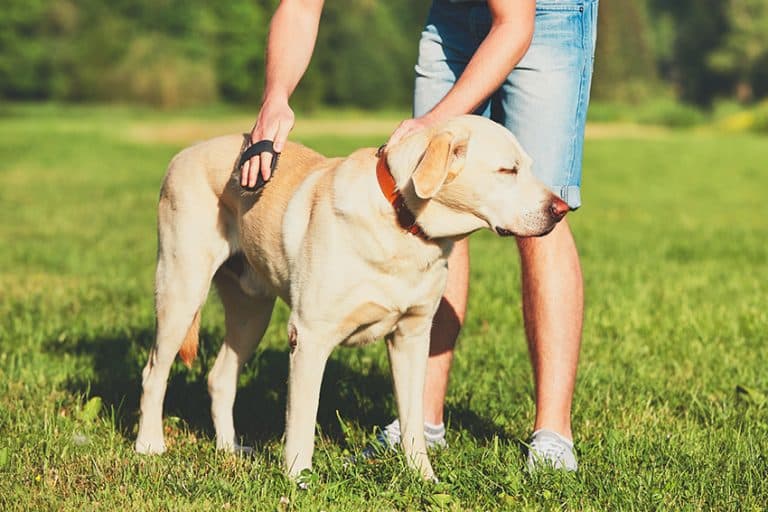
If you have a dog allergy, all is not lost. There are ways to live with Fido and manage your symptoms. Consult an allergist to learn about dog dander allergy treatment options that can minimize or alleviate the allergic response. In addition, you can take steps to keep dander down in your home.
Step 1: Dog Care Tips
Grooming
Regular grooming practices help to remove dead and flaking skin in a controlled environment. Brushing, bathing, and clipping the hair short can reduce the amount of dander your pup sheds.
- Daily Brushing helps to minimize dust and fur. This is particularly important during the shedding seasons in spring and fall. If possible, brush your furbaby outside so that any dislodged skin doesn’t come inside.
- Bathe your pooch at least once a week to keep dander down. You can use a water rinse when Fido’s hair doesn’t need washing. When you use a shampoo, use something that’s gentle on the skin such as an oatmeal-based product.
A dog shampoo for dander like this one from Allerpet can help condition Fido’s skin to keep it healthy. Apply this type of product after brushing your pal.
Diet
What? My dog’s diet can affect how much dander he sheds? Yes! If your pooch has a food sensitivity, it can cause him to itch and scratch more frequently. In addition, a lack of certain supplements, like Omega 3 and 6 Fatty Acids may contribute to dry skin and flakiness. If you notice Fido chewing, licking, or scratching a lot, talk to your veterinarian about whether he needs a change of diet.
Supplements
Just like some food sensitivities cause your dog to shed more dander, some supplements help to reduce dander. The main nutrients that support your pup’s skin and hair are essential fatty acids. Omega 3 and 6 Fatty Acids help to prevent dry, flaky skin that produces more dander.
You can add ingredients like fish or coconut oil to Fido’s diet to promote healthy skin.
Reducing Dander Output
There are some underlying skin or medical conditions that can affect the amount of dander that Fido sheds. If your pal has a food sensitivity or allergy to something in his environment, it often results in more dry, flaky skin cells. Another cause of skin irritation is parasites like fleas and mites. Treating underlying issues may help reduce dander output.
If you see signs like:
- Licking or chewing of the paws
- Scratching all the time
- Reddened skin
- Welts or bumps
contact your veterinarian for an evaluation.
Bedding
Vacuum your furbaby’s bedding weekly. You can also use removable covers that are easy to launder. Remember to wash any blankets and washable toys as well. This will help reduce the level of loose dander and dried saliva.
Personal Hygiene
Wash your hands with soap and water after petting, kissing, or playing with your dog. When you spend an extended time handling Fido, you should change and launder your clothes as well. In some cases, you may need to shower after contact with a pooch.
Step 2: Environmental Care Tips

Use a HEPA Filter
HEPA filters like the Levoit Air Purifier can remove microscopic particles like dander from the air. These specialized filters trap 99.97% of contaminants that are 0.3 microns or larger. In addition, the filters use a pre-filter and carbon filter to provide improved air quality in your home.
Clean Your Carpets and Rugs Weekly
It’s important to vacuum rugs, carpets, and furniture weekly. You may also want to consider washing or vacuuming drapes and stuffed animals. There are several quality cleaners on the market that have a HEPA or premium secondary filter to help you remove as much allergen as possible. Because the vacuuming process can stir up dander and allergen particles, try to clean when allergic family members are out of the house. In addition to a weekly routine, plan regular steam cleaning of your carpets.
Make Your Home Easier to Clean
You can make your job easier by replacing upholstery, rugs, and carpets with washable surfaces like hardwood or tile. Dander sticks to fabrics and rugs more easily than hard surfaces. If you must have a carpet, get one with a low pile to minimize dander build-up.
Keep Fido Out of the Bedroom
It’s sad but true. The last place you want your furbaby at night is snuggled by you in bed. If you have an allergy to dander, you’ll breathe easier and sleep better if your bedroom is a pet-free zone.
Create an “Allergy Free” Zone
In addition to the bedroom, you can restrict your four-footed friend from other parts of the house. Confine Fido to one or just a few rooms and keep them outside as much as possible to minimize dander. You can also use HEPA filters and regular cleaning in pet-free areas to remove as much stray dander as possible.
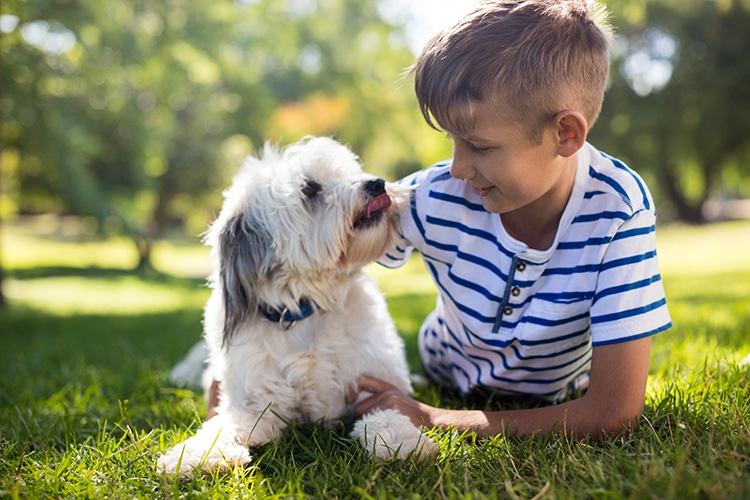
For years, people feared that exposing a baby or toddler to pets might make them more prone to allergies later in life. But recent studies suggest that the opposite may be true.
- A 2017 study published in the Journal of Allergy and Clinical Immunology suggested that exposure to pet allergens before the age of 3 could help to prevent the development of asthma in children.
- The American College of Allergy, Asthma, and Immunology reported on an additional two studies in 2017. These research projects demonstrate a reduced likelihood of asthma and eczema if young children are exposed to dogs.
- Another 2017 study at the University of Alberta revealed that babies from families that owned a pet had an increased level of gut microbes that are linked to a lower risk of developing asthma and obesity.
These are a few examples of recent research, and the results are promising for dog lovers. It appears that early exposure to a furbaby has positive health effects that include reducing the risk of allergies.
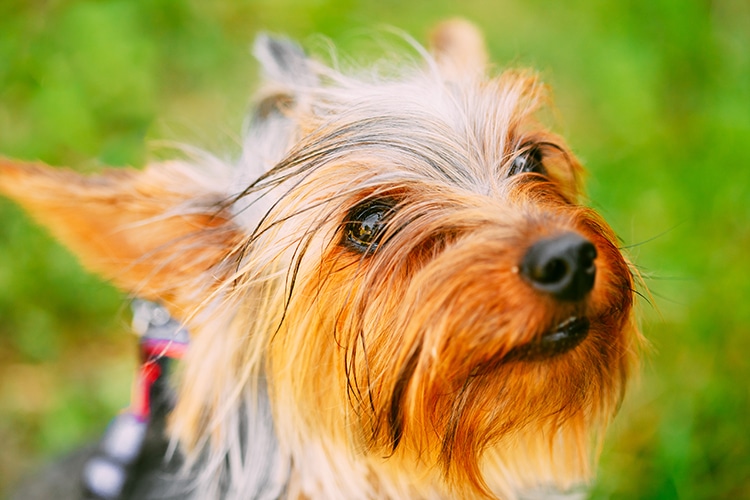
Perhaps you’ve heard the term, “hypoallergenic dog,” but what does it mean? According to Bernadine Cruz, spokeswoman for the American Veterinary Medical Association, “dogs that are more universally less allergenic come from more specific breeds.” So what causes the difference?
What Makes a Dog Hypoallergenic?
Because dander often attaches to pet hair, breeds that don’t shed tend to produce less of the floating particles. Non-shedding pups also have regular visits to a groomer for hair cuts and bathing. These activities also help to minimize dander.
Are Hypoallergenic Dogs Completely Allergen-Free?
Is there really such a thing as a 100% hypoallergenic dog? Not really. Some people can have an allergic reaction even with a so-called hypoallergenic dog. In most cases, however, there are breeds that tend to create less dander and can work well for people with allergies.
What Are the Best Dogs For People With Allergies?
If you have a pet dander allergy but want to have a four-footed friend, your best bet may be a non-shedding dog. Here are some of the breeds that the American Kennel Club recommends:
- Affenpinscher
- Afghan Hound
- American Hairless Terrier
- Barbet
- Bedlington Terrier
- Bichon Frise
- Bolognese
- Chinese Crested
- Coton de Tulear
- Irish Water Spaniel
- Kerry Blue Terrier
- Lagotto Romagnolo
- Lowchen
- Maltese
- Peruvian Inca Orchid
- Poodle breeds
- Portuguese Water Dog
- Russian Tsvetnaya Bolonka
- Schnauzer breeds
- Soft Coated Wheaten Terrier
- Xoloitzcuintli
- Yorkshire Terrier
Final Thoughts
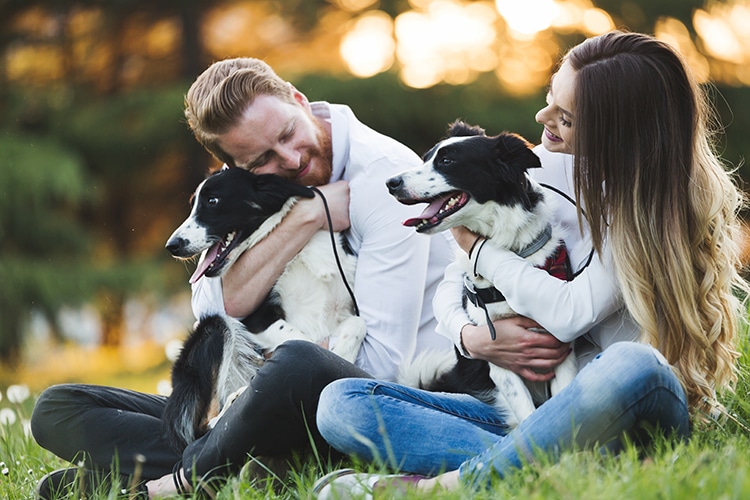
If you or a loved one has an allergy to dog dander, it doesn’t have to be the end of life with Fido. We are so blessed to live in a world that provides ways for allergic dog lovers to coexist with furry friends. With diligent action and appropriate treatment, there’s hope for you to keep enjoying the companionship of a pooch.

